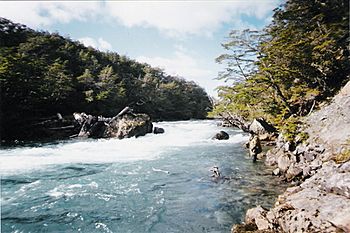Azopardo River facts for kids
Quick facts for kids Azopardo River |
|
|---|---|
 |
|
| Country | Chile |
| Physical characteristics | |
| Main source | Cami Lake (also called Fagnano Lake) 140 m (460 ft) (see Cami Lake) |
| River mouth | Almirantazgo Fjord (Pacific Ocean) 0 m (0 ft) |
| Length | 11 km (6.8 mi) |
The Azopardo River (in Spanish: Río Azopardo) is a short but important river in Chile. It is found on a large island called Isla Grande de Tierra del Fuego, which is at the very southern tip of South America. This river plays a key role by carrying water from a big lake, Fagnano Lake (also known as Cami Lake), all the way to the Almirantazgo Fjord. From the fjord, the water eventually reaches the vast Pacific Ocean.
Contents
What is the Azopardo River?
The Azopardo River is a natural waterway that flows in a westerly direction. It acts like a natural channel, connecting a large freshwater lake to the salty waters of a fjord. The river is about 11 kilometers (around 7 miles) long.
Where is the Azopardo River located?
This river is located in the southern part of Chile. It's on Isla Grande de Tierra del Fuego, which is a big island shared by Chile and Argentina. This area is known for its rugged landscapes and unique wildlife. The river starts at an elevation of about 140 meters (459 feet) above sea level at Fagnano Lake. It then flows down to sea level at Almirantazgo Fjord.
How does the Azopardo River flow?
The Azopardo River begins its journey at Fagnano Lake. This lake is one of the largest in Tierra del Fuego. The river then flows downhill, carrying the lake's water towards the coast. Its path is relatively short, but it's a vital link in the local water system. The river ends where it meets the Almirantazgo Fjord, which is a long, narrow arm of the sea.
What is the Azopardo River's importance?
The Azopardo River is important for a few reasons. It helps drain Fagnano Lake, preventing it from overflowing. It also forms the northern boundary of Yendegaia National Park. This national park is a protected area known for its beautiful forests, mountains, and glaciers. The river helps define the park's natural borders. It is also a part of the unique ecosystem of Tierra del Fuego.
See also
 In Spanish: Río Azopardo para niños
In Spanish: Río Azopardo para niños
- Marinelli Creek

